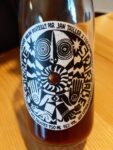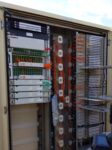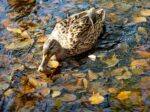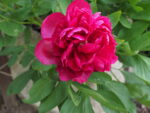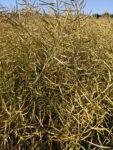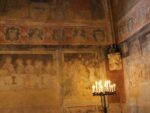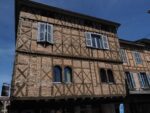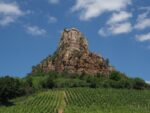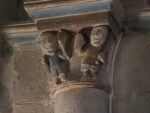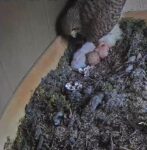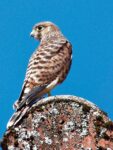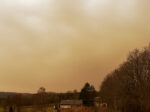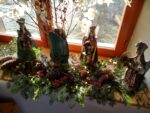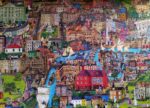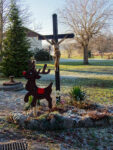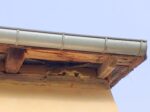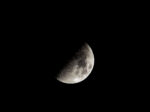To download a printable PDF version (no pictures)
click on this link E2E2022no3.pdf (five A4 pages)
There are clickable links to eight different photograph galleries in the text
 The white frozen grass under the hooves of the tan cattle, the hints of snow, and a sighting of St Nicolas confirm that Autumn has now given way to Advent.
The white frozen grass under the hooves of the tan cattle, the hints of snow, and a sighting of St Nicolas confirm that Autumn has now given way to Advent.
It has been an unseasonably warm and sunny Autumn here as elsewhere, so the autumn colours have been lemon, gold and tawny against the dark conifers. We returned from the UK at the beginning of October via an exhibition at the Louvre/Lens on Champollion, the Frenchman who deciphered the hieroglyphs on the Rosetta Stone. We found the exhibition disappointing as it was more about his life than the deciphering.
All was well back in Entre-deux Eaux, apart from parts of the field which John mows, which had been dug up by boars, leaving large lumps of turf. As we write, a local gardener is wheeling quantities of earth from his truck to fill and level the afflicted areas. A more charming November visitor was a very young deer, although it showed possible shotgun pellet marks. But we are not so enamoured of the latest portly nocturnal visitor to our balcony, who has kept John busy clearing up its scat and disinfecting. We suspect it is another pine marten.
On a more cheerful note, the continuing sunny October weather here was ideal for harvesting the green beans, autumn raspberries, blackberries, walnuts, a couple of pumpkins and some gigantic courgettes and squash. Later we picked apples and the first quinces we’d had for many years (we thought the quince tree had been badly damaged from fireblight about ten years ago but it has slowly recovered). The barn shelves have now been replenished with 28 jars of marrow, ginger and lemon jam, and nine of quince jam. The fruit drawers in the freezer are packed tight with blackberry and apple purée, more apples are boxed up in the barn and others stored as dehydrated slices, and we have had tasty nut roasts from some of the walnuts. We are still picking autumn raspberries at the beginning of December! Given our harvest, we should have been equipped to accurately guess the weight of the pumpkin displayed at l’Imprimerie restaurant (and so win a free meal for two) but we had not thought to weigh ours. Pumpkins abound here in all shapes and degrees of knobliness, and do not all disappear for grinning Halloween lanterns. There must be about nine rotting away on ex-farmer Vozelle’s muck-heap.
After our time away, we soon felt the need to be revived by some good French cooking, so drove over to the book village for lunch at l’Imprimerie, where we enjoyed one of chef Morgan’s best surprise menus. As the small restaurant was full and service was slow, lacking one of the usual waiters, we were given a complimentary glass of wine at the start, which of course made any delays quite bearable, especially as we weren’t in a hurry anyway. When we returned there at the start of December, there was an additional member of staff, faster service and no free wine! The new waiter was enthusiastic, interested in the food, and related very well to all the customers (whereas the old one has his grumpy days when explaining about the surprise menu to new guests and presenting the unusual dishes sounds a chore); apparently the new man used to be a nurse, and was finding a busy restaurant quite a rest cure compared to nursing. Each of the December dishes was inventive and tasty, and as so often, the organic wines proposed were unusual.
We watched as other diners tried the proffered red wine, hesitated, and bravely decided to go ahead with it; but the couple at the opposite table tasted it, wrinkled their noses and declined the cloudy, fruity red liquid, and were brought a more conventional one. John was intrigued by his first sip, accepted happily and we really liked it with the fire-roasted duck. A propos the duck, the often grumpy waiter was on sparkling form and even made a joke when he brought the quince dessert, about how we first had the coin-coin (quack-quack) and now we had the coing (quince) to which we dutifully pulled a face. Perhaps having a subordinate nurse-waiter to share his burden has cheered him up!
Earlier in the year, before we left for the UK, we had watched a new fibre cable being brought along the road on the telegraph poles and then underground by the regionally-owned company responsible for the new public fibre optic infrastructure, and had wondered when a commercial firm would approach us to connect us to their internet and phone service. Nothing seemed to have happened in our absence, but on our second day back, an SFR rep rang the doorbell to offer their service at a bargain introductory rate, so after discussion, we signed a contract and agreed a date for the technician to connect us.
Before the technician arrived, we moved a lot of boxes in the attic, as well as Helen’s computer and desk to gain access to the entry point of the old cable under the eves. But with these old houses, nothing is straight forward. The technician was delayed at his first job beyond our 8-12 time slot, then worked through the sacred French lunch hours to sort out the cabling, pulling it through the underground channel from the box at the end of the road. He then announced that the existing hole under the eaves, through which the copper telephone cable came in, was not large enough for the new cable to be pulled through (the old cable had been cemented in when we had the rendering replaced), but, as he was not permitted to drill through walls, he would have to come back after we had employed a mason to enlarge the hole. In exasperation, John got a chisel, climbed up the technician’s ladder and did the necessary. Surprisingly, all this was conducted in good humour and in colloquial English, the technician having spent over 12 years in England with his family (and attended the Lycée Français there and then worked as a pub manager).
After connecting our two strands of the twelve-strand cable to the main box in a regard, he had to drive over to another village (Remomeix, where the little airstrip and flying club is) to do the final connection (John went with him to watch), before returning to install the router box. It was several days before we realised that our land line phone was not working, which required a trip into the SFR shop in Saint-Dié as it had not been activated following the change of supplier. We were fortunate, however, as we later heard that the strands of a neighbour’s new SFR fibre connection had been accidentally cut by a rival firm while connecting another neighbour to their service.
No doubt John fell foul of French Union demarcations by enlarging the hole in the wall. But Helen also unwittingly fell foul of medical demarcation lines. Concerned about an increasingly large growth on her chin while we were in the UK, she phoned the dermatologist in Saint-Dié (who had treated her melanoma) for an appointment after our return. But it turned out that she should have first gone to our GP for a letter of referral, as dermatologists, unlike ophthalmologists, gynaecologists and paediatricians, have not negotiated a direct access arrangement, so the letter had to be written retrospectively by our GP after the appointment. To add insult to the dermatologist’s dignity, Helen forgot that unlike most health professionals nowadays, her dermatologist does not accept payment by bank card; she had forgotten to take our rarely-used cheque book and did not have sufficient cash, so had to return after pooling cash resources with John. (We have to pay doctors directly here, and then wait for partial reimbursement from the state and from our complementary medical insurance).
However, after those blunders on Helen’s part, the French health care system proved attentive and excellent. The dermatologist’s test revealed an epidermoid (or squamous cell) carcinoma, which was removed in day surgery at Nancy, and the local nurses have been coming to the house every 2 days to change the dressings and to finally remove the stitches. Helen had been expecting more pain when prescribed 14 boxes of paracetamol, but has needed none of them.
Meanwhile John had been trying out some different hearing aids, but was not happy with the sound quality, and the effect (or lack of) on his tinnitus, but the Optical Center felt he has come to the end of the period he can spend trying out aids they can provide.
When we hear about the problems in the NHS, we feel very lucky with our treatment here. But similar problems are building up here. The doctors held a two-day strike at the start of December, as their self-employed but regulated pay is below that of salaried hospital staff. There is also a shortage of GPs, especially in rural areas, where there are dessertes ruraux. The sign at the side of the dual carriageway round one of the small towns to the north of us has returned, announcing to any passing potential candidates that Raon l’Etape is looking for GPs. Our much lamented GP was not replaced after his retirement. Surprisingly there also is a dearth of chiropodists, who are better paid than GPs, and are turning away new clients. When one of the Brain Exercise group noticed that a new chiropodist had set up in Sainte Marguerite, Helen booked in rapidly, before her list had built up. Pharmacies are now where the money is perceived to be made. Today’s visiting nurse sounded bitter that the government has handed pharmacies the right to do the vaccinations against flu and Covid-19. But, although we had our flu vaccinations in mid-October, it proved difficult to get our fifth Covid-19 vaccination done until December, as pharmacies were initially vague as to whether a GP prescription was needed to prove a special case. The French government has not publicised the current rules very clearly and the uptake of follow-up vaccinations has been low.
The Brain Exercise group in Sainte Marguerite is an excellent source of information, and issues of national as well as personal importance are thoroughly discussed before exercises start. The October meeting thought it entirely appropriate that Helen and John were in London at the time of Queen Elizabeth’s funeral, and the qualities of the remaining members of the Royal Family were thoroughly assessed. Group members are also always concerned over members’ health and housing. The same cannot always be said for the much larger group of Entre-Deux-Eaux (and now surrounding villages) Oldies who can be more insular. At their October meeting, none of people with whom Helen usually plays games were present, and no one offered to include her in their group, so she sat in silence throughout.
The Brain Exercise group were equally animated at their session on 2 December. It was Helen’s turn to provide the exercises and the food, but first there was animated discussion of the French transport strikes, doctor’s strikes and bioanalysis laboratory strikes, details of an absent member’s move following her divorce, and jokes were recounted. Then it was Helen’s turn. She started with some easy picture exercises from a French site (though some people had difficulty telling the right shoes and gloves from the left, and piecing together the parts of a hat picture. But they found the next exercise, a logic grid a bit like a battleship grid, too hard and gave up, but relished some mathematical calculations from The Times. Some more picture exercises (darts board scores and French saints and foods) from the French site followed. Then the kettle was boiled for coffee and tisanes, apricot juice poured, sponge cake sliced and served with some of the newly-made marrow, ginger and lemon jam and we rounded off with some Christmassy chocolate spice biscuits. The Christmas touch seemed just right as a superbly-robed St Nicolas walked past the window – perhaps on his way to visit a school. John’s jam was much admired. “Has he got a brother?” an elegant widow demanded. “But his brother might not cook as well,” another cautioned.
As you can see, this autumn seems to have been spent mainly on harvesting, eating, medical appointments and games. But we have also enjoyed colourful local walks and scenery, in particular the Bank Holiday morning when we drove over towards Gérardmer and parked by Lac de Longemer. We used to take the canoe and swim there when the children were younger, but had never walked all the way round.
We thoroughly enjoyed the colours, reflections, and aquatic wildlife as we strolled round, but half way round began to feel it was time for a coffee. As we watched a boat tying up, we realised it was mooring below a large terrace with tables and people, and we speeded up. We sat there in the warm sunshine over our large coffees, and after a while ordered a pizza to share, and then had another coffee to sustain us on the second part of our circuit.
A day later we drove over one of the passes to one of the walled Alsace wine villages, Riquewihr. The village itself was heaving with tourists, so we cut short our proposed stroll round the quaint old streets. The restaurant AOR where we were belatedly celebrating John’s birthday was outside the walls, at the foot of the vineyards, so we didn’t have to face the crowds. We had not been before, and when we made our way up the steps it was disconcerting to find the door firmly closed against us. However, we rang the old fashioned bell pull, as instructed, and were warmly received in the quirkily decorated interior. The tables looked as if their legs were old industrial machine parts and the tops were heavy wood (and ours had a hole in the centre where we could easily have lost some dishes or glasses) and were apparently designed by chef. Chains of spoons against scarlet hung in a circle. Unsettling modern art and black and red panels adorned the walls. The table mats were old 78rpm records. The food, however was inventive and tasty, with influences from his work around the world.
Our dessert of a smoking chocolate cigar, his signature dish, was created during his stay in Los Angeles around the time of the Clinton/Lewinsky scandal. It is somewhere we would happily return to. We had thought of a walk afterwards at the Col de Bonhomme, but it was getting cooler by the time we reached there.
Once the weather turns damp, misty and cold in November, we rarely see our neighbours out walking or gardening, but on 25 November our normally quiet narrow road was busy. First to ring our doorbell was the nurse to change the Helen’s dressing (we saw the neat scar and stitches for the first time). Next at the door was the oil delivery man who needed to run a long hose pipe from his tanker to our tank in the barn. He kindly reversed for our neighbour, Claudine, who was waiting to get past his tanker, but she drove too close to the edge of the road and a front wheel went into the ditch and got stuck. Perhaps she was distracted by her three noisy grandchildren. The tanker driver and John looked for planks and rope in our outbuildings, but our rope wasn’t strong enough, so Claudine’s partner went home for a tow bar which was connected to the tanker and it reversed, pulling her out. Meanwhile her grandchildren had been racing around and climbing on the car roof and other neighbours had gathered to watch and to have a good gossip. It was only at this point that one of the farm tractors (which normally thunder past and would have been useful for extricating the car from the ditch) turned up. One of the neighbours, Jean-Marie, who had shuffled up in his crocs, then offered to repair the tyre on our sit-on mower, which he noticed in the open outbuildings, John rode it down the road and J-M returned it, repaired, before lunch. Then in the afternoon his wife, Danielle, and Helen went down for tea and more animated gossip with one of the E2E Oldies Scrabble group who lives in the oldest house in the village. Another scrabble player was already there, and the foursome settled down to coffee and blueberry clafoutis and non-stop gossip and did not even notice the heavy rain outside. It was dark when everyone left, so we had to be very careful to avoid the big puddles up our road. Thank goodness one of the big tractors didn’t come racing past, otherwise we would have got soaked.
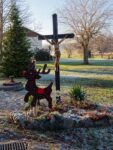 It is brighter up our normally dark road now that December has arrived as houses are putting up their Christmas lights. Has Annick (the Laines’ daughter) got even more lights than last year? When we drove over the hills to Alsace last week, the huge teddy bears were starting to take up residence on windowsills in Sainte-Marie-aux-Mines, but have not caught on here. Entre-deux-Eaux commune has not yet arranged its cheeky hardboard reindeer round the village. Last year there was one at the foot of the cross on the corner of our road.
It is brighter up our normally dark road now that December has arrived as houses are putting up their Christmas lights. Has Annick (the Laines’ daughter) got even more lights than last year? When we drove over the hills to Alsace last week, the huge teddy bears were starting to take up residence on windowsills in Sainte-Marie-aux-Mines, but have not caught on here. Entre-deux-Eaux commune has not yet arranged its cheeky hardboard reindeer round the village. Last year there was one at the foot of the cross on the corner of our road.
We have been hearing about postal problems in the UK, so have dug out a black and white Christmas card John made 30 years ago in 1992. We will send it with this newsletter, so that you can print it out. It shows the above-mentioned cross with a bike rather than a reindeer. In those days, our neighbour Gerard was still working, and would cycle down to the corner each morning, prop his bike against the cross (in case Jesus fancied cycling round the village?) and get a lift to the next village. It may be an old design, and only on paper rather than card, but it comes with this year’s warmest wishes for a happy Christmas and for good health and interesting activities in 2023.


